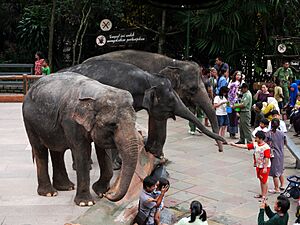Sumatran elephant facts for kids
The Sumatran elephant (Elephas maximus sumatranus) is a special kind of Asian elephant that lives only on the Indonesian island of Sumatra. Sadly, these elephants are in great danger. In 2011, experts changed their conservation status from "endangered" to "critically endangered." This means their numbers have dropped by a lot, about 80% in the last 75 years.
The biggest problems for Sumatran elephants are losing their homes, their homes becoming damaged, and their homes getting broken up into small pieces. Also, poaching (illegal hunting) is a big threat. Over the last 25 years, more than two-thirds of the places where elephants could live have disappeared. Many of the remaining forests are too small for healthy elephant groups to survive.
Contents
What Makes Sumatran Elephants Special?
Asian elephants are generally smaller than African elephants. They have the highest point of their body on their head. The end of their trunk has one finger-like part. Their back is usually curved or flat. Female elephants are often smaller than males. They also have short tusks or no tusks at all.
Sumatran elephants stand between 2 and 3.2 meters (about 6.5 to 10.5 feet) tall at the shoulder. They can weigh from 2,000 to 4,000 kilograms (about 4,400 to 8,800 pounds). Their skin is lighter than other Asian elephants, like the Sri Lankan elephant and the Indian elephant. They also have fewer light spots on their skin.
Where Do Sumatran Elephants Live?
Sumatran elephants used to live all over the island of Sumatra. In the 1980s, the Riau Province was thought to have the most elephants, with over 1,600 individuals. A survey in 1985 suggested that between 2,800 and 4,800 elephants lived in 44 different groups across Sumatra. However, by 2002, in Lampung Province, only three groups of elephants were left.
By 2008, elephants had disappeared from 23 of the 43 areas they lived in back in 1985. This shows a very big drop in their population. By 2008, they were gone from West Sumatra Province and were at risk of disappearing from North Sumatra Province too. In Riau Province, only about 350 elephants remained in nine separate areas.
As of 2007, it's estimated that there are only about 2,400 to 2,800 wild Sumatran elephants left. These elephants live in 25 separate groups across the island. More than 85% of their homes are outside of protected areas. In Aceh, elephants with radio collars preferred living in thick natural forests near rivers and mountains below 200 meters (about 650 feet) elevation. From there, they would move into other types of forests and look for food near human villages, mostly at night.
Elephant Life and Habits
Female elephants usually stop having babies after they are 60 years old. In the wild, elephants can live for about 60 years. Elephants in zoos or special centers have lived longer. Female elephants in captivity have lived up to 75 years, while males have lived up to 60 years.
Elephants usually give birth at night, and the birth takes about 10 seconds. A healthy baby elephant can usually stand up on its own after just 30 minutes. Female elephants grow faster and reach their full size earlier than male elephants. Male elephants continue to grow as they get older and become larger.
Why Are Sumatran Elephants in Danger?
One of the main reasons Sumatran elephants are in danger is because their forest homes are being turned into places for people to live, farm, and grow crops like palm oil. This means many elephants have been moved from their homes or even killed. Between 1980 and 2005, about 69% of the possible Sumatran elephant habitat was lost in just one elephant generation.
Many elephants found in special camps were caught after they raided farms in protected areas. The destruction of elephant homes for illegal farms and palm oil plantations is still happening. From 2012 to 2015, 36 elephants were found dead in Aceh Province. They died from things like electric shocks, poison, and traps. Most of these dead elephants were found near palm oil plantations. Elephants often try to destroy these plantations because they block their path to food.
Sumatran elephants like to live in low-lying areas with gentle slopes, especially near rivers and mountain valleys. People also prefer to live in these same areas. This causes problems between elephants and humans as they compete for space. Efforts to protect crops often involve chasing elephants away from farms or moving them deeper into the forest. This makes it harder for some elephants to reach the areas they prefer.
Protecting Sumatran Elephants
The Asian elephant (Elephas maximus) is listed under CITES Appendix I. This means it is highly protected internationally. Sumatran elephants are also protected by Indonesian law.
In 2004, the Tesso Nilo National Park was created in Riau Province. This park helps protect the Sumatran elephant's home. This forest is one of the last places big enough to support a healthy group of elephants.
Between 1986 and 1995, 520 wild elephants were captured. They were kept in six Elephant Training Centres. These centers were set up in different provinces of Sumatra. Capturing wild elephants stopped in 1999. This was because it was too expensive to care for the captive elephants. Also, the centers couldn't pay for themselves, and some became too crowded. By the end of 2000, 391 elephants were still in these centers. A few more were in zoos, safari parks, and tourist areas.
See also


